VM 568 Final Exam
1/83
There's no tags or description
Looks like no tags are added yet.
Name | Mastery | Learn | Test | Matching | Spaced |
|---|
No study sessions yet.
84 Terms
Which of the following may be of benefit in preventing canine calcium oxalate uroliths?
A) Vitamin C
B) Vitamin D
C) Hydrochlorothiazide (a thiazide diuretic)
D) Allopurinol
C.
Ammonium urate cystoliths are typically encountered in which of the following?
A) Dogs with primary hyperparathyroidism
B) Dogs with urease producing UTIs
C) Cavalier King Charles spaniels
D) Dogs with portal vascular anomalies (portosystemic shunts)
D.
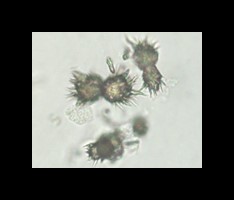
What type of crystal is shown in the photograph of urine sediment?
Ammonium urate
T/F: Ureteral Stents are placed outside of the ureters to enable flow of urine from the renal pelvis to the urinary bladder.
False
T/F: Ureteral Stents can be flushed postoperatively with tEDTA to help minimize the risk for device calcification and therefore reobstruction.
False
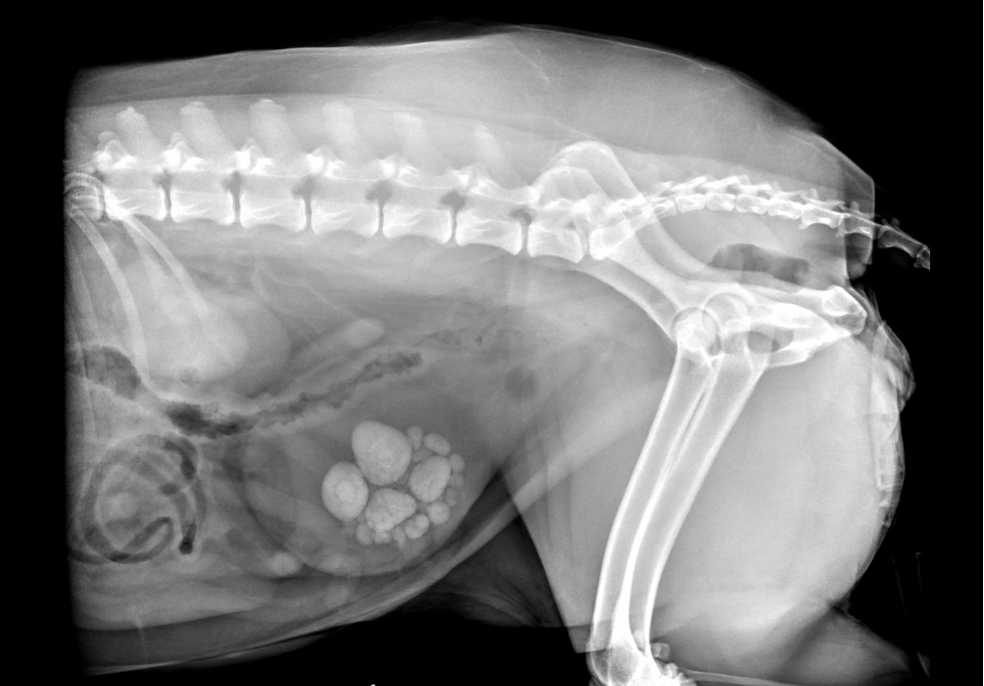
What is should in the radiograph?
A. Nephroliths
B. Ureteroliths
C. Cystoliths
D. Urethroliths
C.
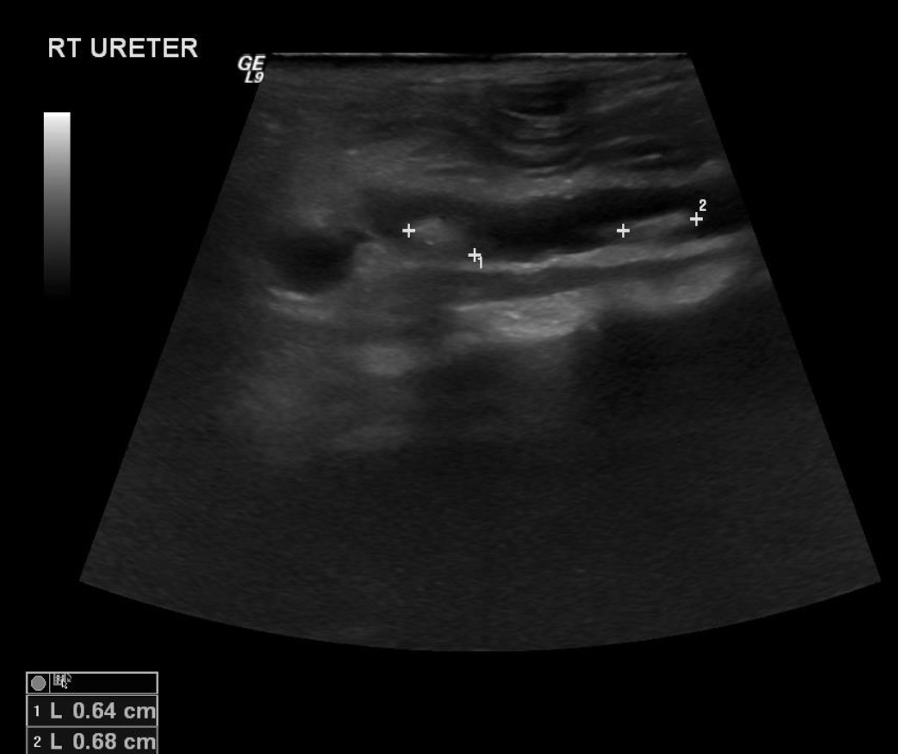
What is should in the radiograph?
A. Nephroliths
B. Ureteroliths
C. Cystoliths
D. Urethroliths
B.
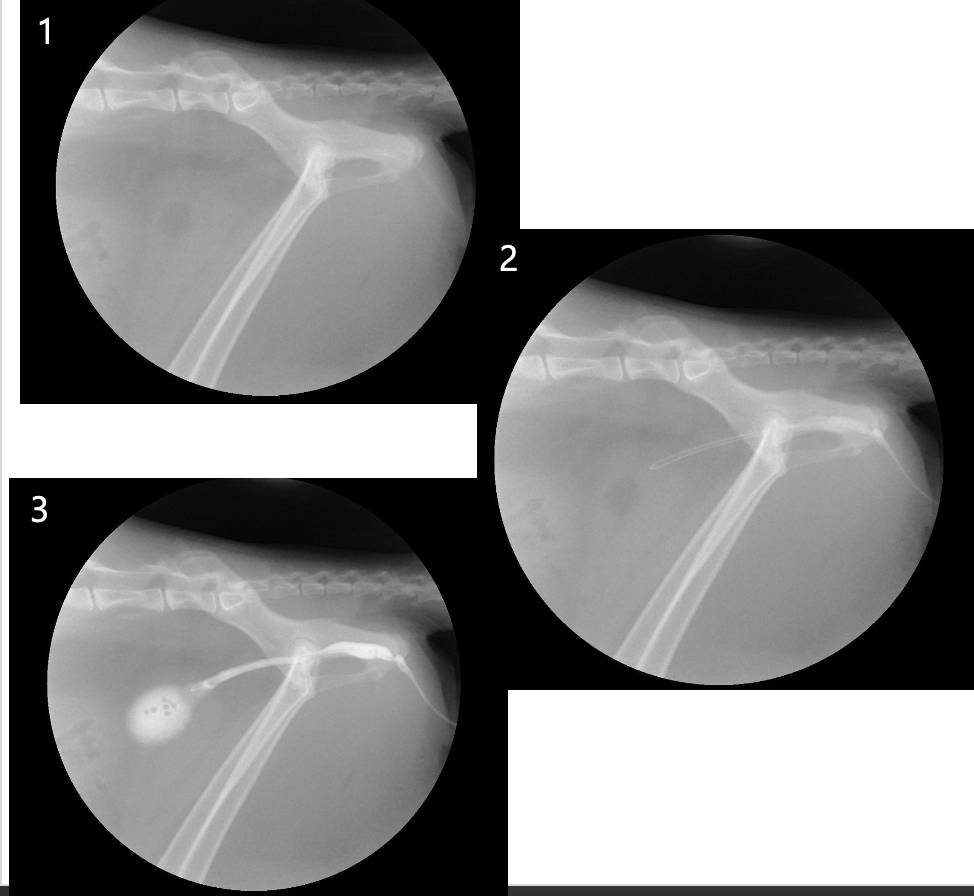
What is should in the radiograph? Select all that apply
A. Nephroliths
B. Ureteroliths
C. Cystoliths
D. Urethroliths
C and D
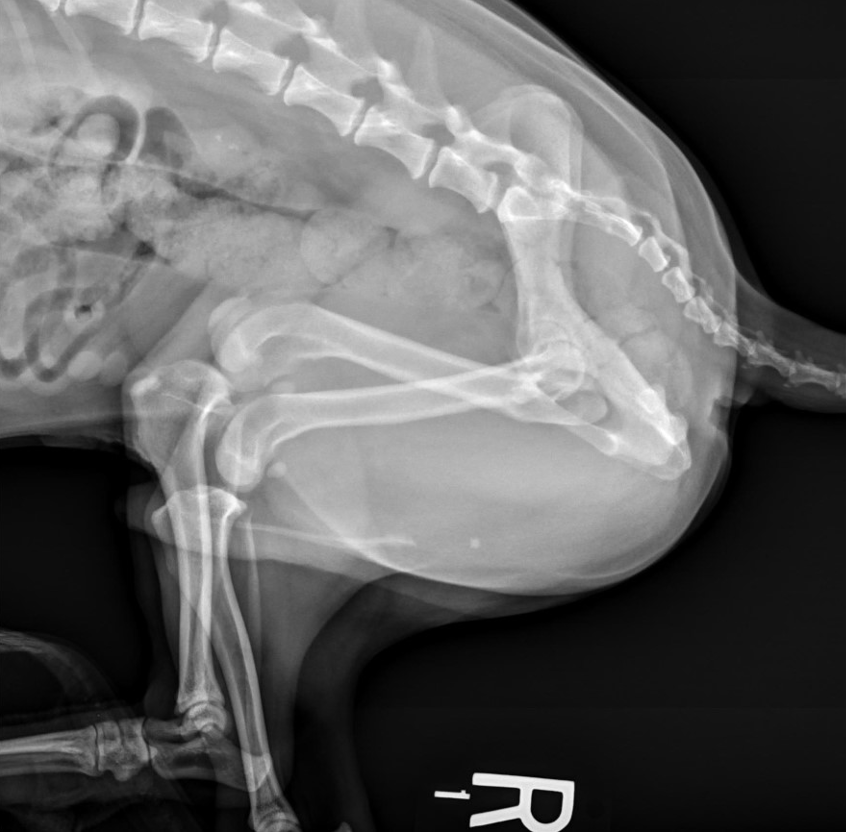
What is should in the radiograph? Select all that apply
A. Nephroliths
B. Ureteroliths
C. Cystoliths
D. Urethroliths
D.
What is the difference between radiograph vs ultrasound when quantifying stones?
Radiographs provide a 2D projection where overlapping stones remain visible, making them more effective for counting multiple stones. In contrast, ultrasound may miss stacked stones because it images in slices, meaning deeper stones can be obscured by those above them.
Which of the following is FALSE regarding survey radiographs in the diagnostic approach to urolithiasis?
a) Survey radiographs are good for detection of the number of stones
b) All stone types are visible on radiographs
c) Radiographs may miss small (<3mm stones)
d) Radiographs may give an estimate of mineral composition
B.
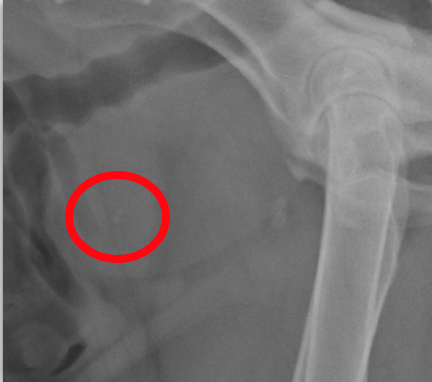
How should we remove these stones?
a) Cystotomy
b) Extracorporeal shock wave lithotripsy
c) Intracorporeal show wave lithotripsy
d) Voiding urohydropropulsion
D.
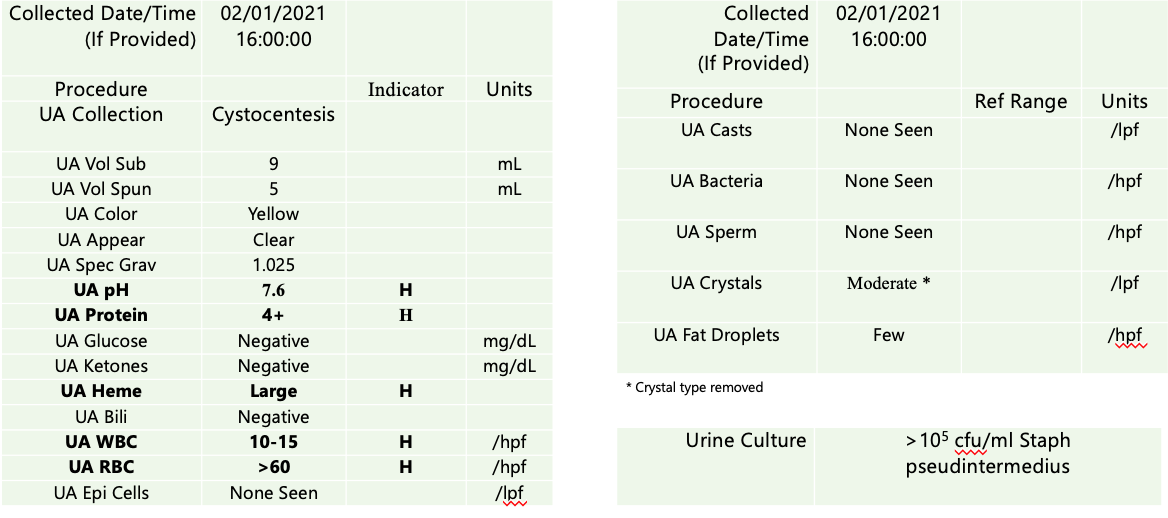
Gator, 2 YO FS Mixed breed dog, presented with hematuria, dysuria, stranguria, has had recurrent UTI’s with the following UA results. A large radiopaque smooth stone seen on radiographs. What is the most likely stone type?
A. Struvite
B. Calcium oxalate
C. Cysteine
D. Urate
A.
What is the recommended treatment for suspected struvite cystoliths?
Medical dissolution
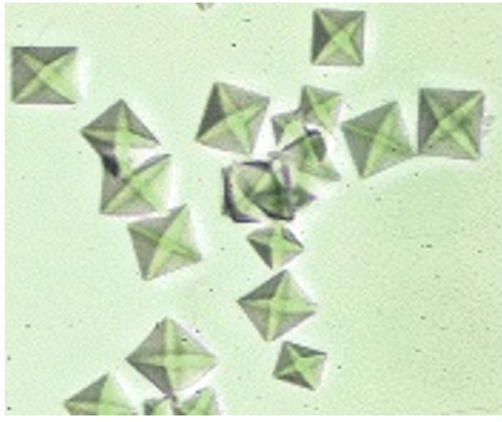
What type of crystal is shown?
A. Struvite
B. Calcium oxalate dihydrate
C. Cysteine
D. Ammonium urate
B.
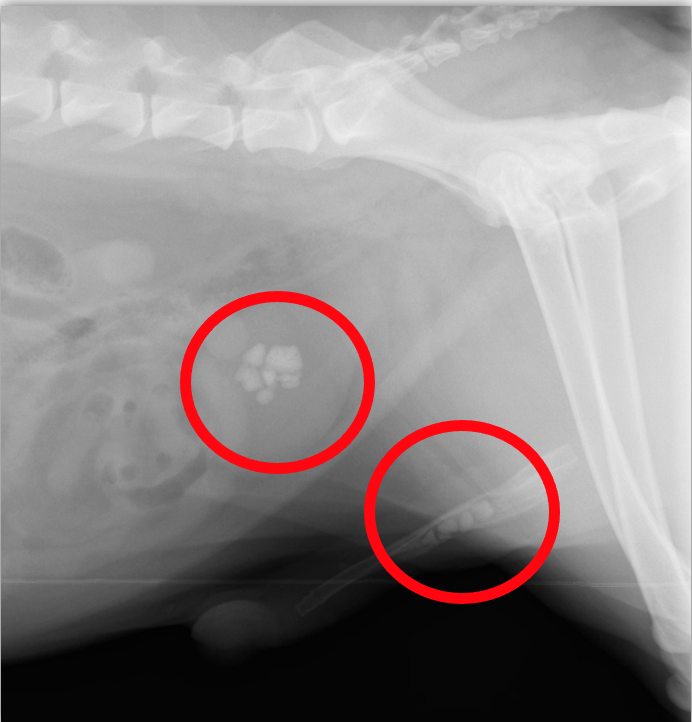
What should we do with these stones?
a) Medical dissolution
b) Cystotomy
c) Intracorporeal show wave lithotripsy
d) Voiding urohydropropulsion
e) Consider multiple removal types
E.
T/F: If hypercalcemia is present in a dog with calcium oxalate stones then you must diagnose and treat the cause of the hypercalcemia to prevent recurrence
True
Ammonium urate stones are encountered in which of the following situations?
a) Dogs with urease producing UTIs
b) Dogs with primary hyperparathyroidism
c) Dogs with portal vascular anomalies (PSS)
d) Dogs with a mutation in the SLC2A9 uric acid transporter
e) Both c and d
E.
What drug can be used in the management of ammonium urate stones?
a) Hydrochlorothiazide
b) Vitamin D
c) Vitamin C
d) Allopurinol
D.
T/F: Alkaline urine (high pH) predisposes to urate stones
False
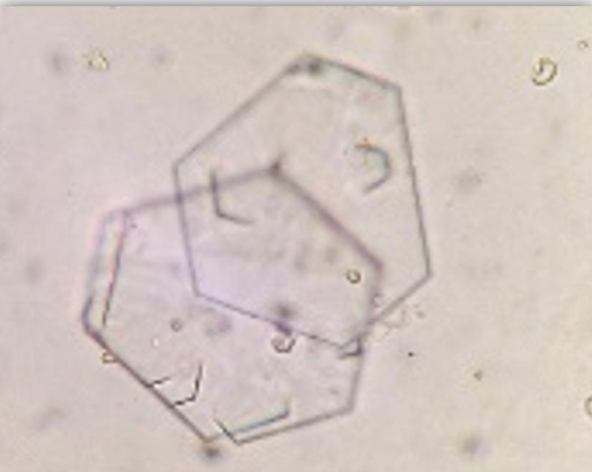
What type of crystal is shown?
A. Struvite
B. Calcium oxalate dihydrate
C. Cysteine
D. Ammonium urate
C.
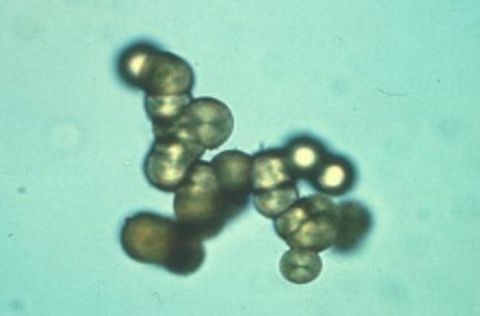
What type of crystal is shown?
A. Struvite
B. Calcium oxalate dihydrate
C. Cysteine
D. Ammonium urate
C.
Name two potential sequelae of uroliths
Urinary obstruction
UTI
T/F: Crystalluria is a risk factor for urolith formation and will always represent the presence of uroliths
False
On the dorsal aspect of the male urinary bladder, the ureters run dorsal to what structure prior to entering the urinary bladder at the UVJ?
a. Spermatic cord
b. Ovarian pedicle
c. Vas deferens
d. Lateral ligaments
C.
What type of muscle is the detrusor muscle?
a. Striated muscle
b. Smooth muscle
c. Longitudinal muscle
d. Circular muscle
B.
What type of muscle is the urethral muscle?
a. Striated muscle
b.Smooth muscle
c. Longitudinal muscle
d.Circular muscle
B.
What type of muscle is the periurethral muscle?
a. Striated muscle
b.Smooth muscle
c. Longitudinal muscle
d.Circular muscle
A.
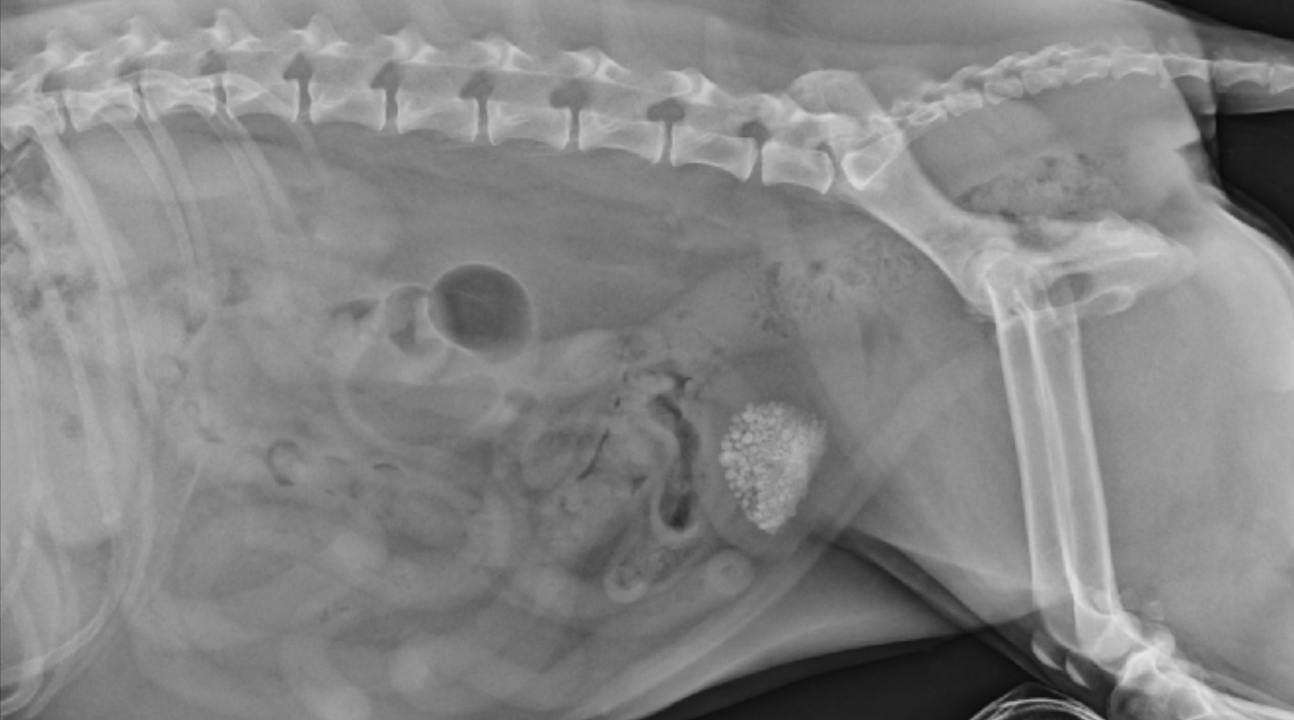
Why would the Internal Medicine Service not schedule Baby Dior for a cystoscopy stone retrieval procedure?
a. Scoping is not allowed in male dogs
b. There are too many stones requiring retrieval
c. The male urethra is too small to allow stone retrieval
d. All stones will dissolve with a dissolution diet and retrieval is not
necessary
B.
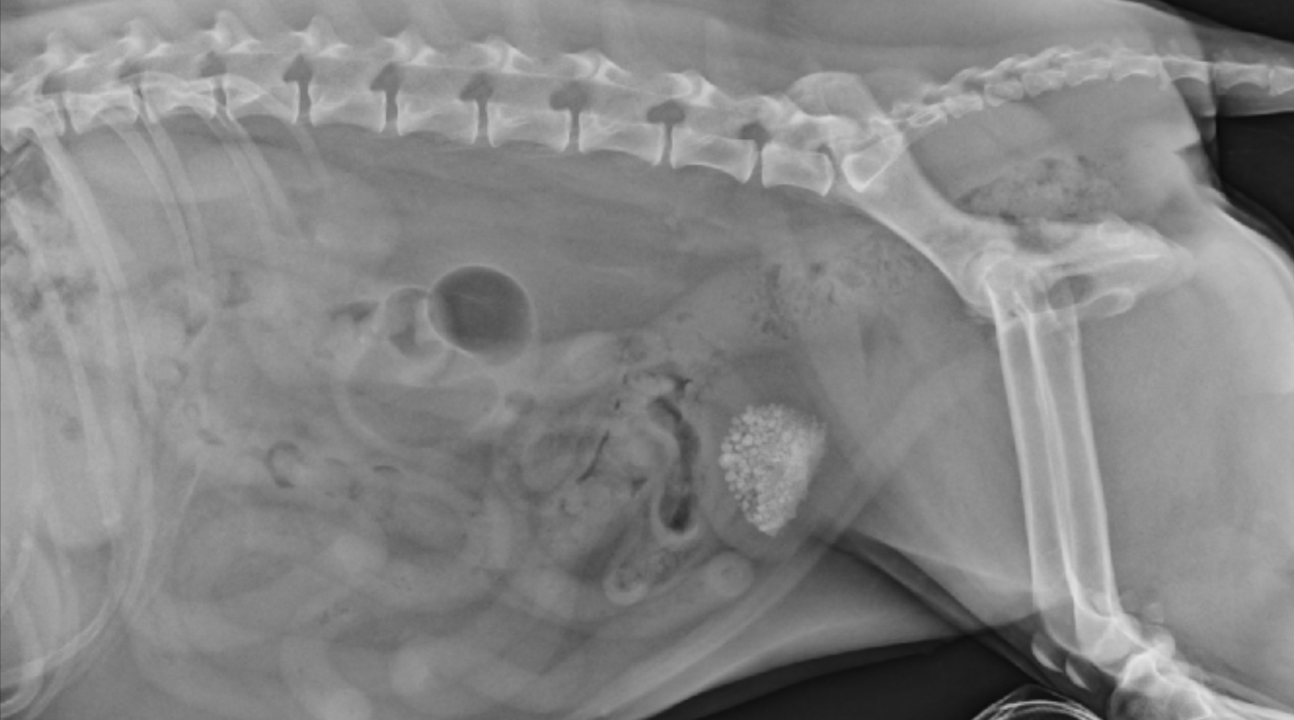
Internal Medicine plans to transfer Baby Dior to the Soft Tissue Surgery Service for intervention...
What surgical approach will you use?
a. Abdominal explore (celiotomy)
b. Cranial midline laparotomy
c. Caudal midline laparotomy
d. Flank approach
C. → Could perform a full abdominal explore, but routine cystotomy surgery can be performed simply through a caudal midline laparotomy.
What suture will your cystotomy closure be made with and in what closure pattern?
Absorbable suture monofilament
Absorbable barbed suture
Single layer – simple continuous pattern
Double layer – simple continuous oversewn with inverting Cushing’s pattern
What samples will be submitted for analysis post urolith removal via cystotomy?
Stone analysis
Urine culture/stone culture (aerobic/anaerobic)
Histo of a bladder apex biopsy
List common indications for surgical intervention of the urinary bladder and/or urethra
Urinary cystic calculi
Traumatic disruption
Neoplasia
What tests are used to assess abdominal fluid for the presence of urine?
a. BUN/Creat
b. Creat/albumin
c. Creat/K+
d. BUN/K+
C.
What numerical values would indicate the presence of uroabdomen?
K+
Dog→ 1.4:1
Cat → 1.9:1
CRET
2:1
How can we keep the urinary bladder empty following delicate repair
to minimize tension on the urinary bladder and optimize healing?
Placement of a urinary catheter (foley urinary catheter)
What surgical disease seen and what treatment is availalble?
Urethral prolapse → urethral resection and anastomosis, urethropexy
Urethral obstruction in cats can be due to what?
Uroliths
Sludge
Blood clots
T/F: Surgical intervention is always needed for renoltihs
False - no need to intervene if not causing obstruction
What is a perineal urethrostomy surgery?
Amputation of the penis and anastomosis of the urethral mucosa to the epithelium of the perineum, performed in male cats
When performing a PU surgery in a male cat, what two structures are important to identify before performing the amputation?
Bulbourethral glands and penile retractor muscle (which will be removed)
What surgical procedure can be used to remove these calculi from the kidney?
a. Nephrectomy
b. Nephrotomy
c. Nephrostomy
d. Nephroitomy
B.
What complications could arise from doing a nephrotomy?
Risk for worsening azotemia
Risk for major hemorrhage
What if we just wanted to assess the renal tissue... what surgical
options do we have to collect a sample?
Renal biopsy or nephrectomy
When is it appropriate to perform a nephrectomy?
Performed in non-azotemic patients for neoplasia, accidental ureteral ligation during other abdominal surgical procedures.
If the ureteral stones have become obstructive, what surgical interventions are available?
Ureterotomy
Neoureterocystotomy for distal calculi (end of uterer only)
Ureteral stenting
SUBs
How is a ureteral stent different from a SUB?
Ureteral stent – device that is placed within the ureter to maintain urine flow from the kidney to the urinary bladder.
SUB device – device that is placed outside of the ureter to maintain urine flow from the kidney to the urinary bladder.
T/F: Uterer stents have less complications than SUBs
False - SUBs have less complications
Which of the following conditions is not a direct complication of perineal urethrostomy (PU) surgery in cats?
A) Stricture formation
B) Recurrent urinary tract infections (UTIs)
C) Rectal prolapse
D) Incontinence
E) Azotemia
E.
Male dog version of a PU
Scrotal urethrostomy
What is the correct placement of a ureteral stent?
A) Within the ureter between the renal pelvis and the urinary bladder
B) Entirely within the renal pelvis
C) Positioned only in the urinary bladder
D) Placed in the urethra and into the urinary bladder
A.
T/F: SUBs can be flushed with tEDTA to help minimize the risk for device calcification
True
What is lithotripsy?
Minimally invasive procedure that uses shock-waves to brak down urinary stones into smaller fragments for easier passage or removal
On a contrast cystography, the presence of centrally located defects within the dependent portion of the contrast puddle is most indicative of which diagnosis?
A) Blood clots
B) Cystoliths
C) Urethral stricture
D) Bladder neoplasia
B.
On a contrast cystography, irregularly shaped, poorly marginated filling defects that may be located centrally or peripherally are most suggestive of:
A) Blood clots
B) Cystoliths
C) Urethral stricture
D) Bladder neoplasia
A.
What are the three most common locations for obstructive urolithiasis?
Prostatic urethra
Caudal to isthium
Os penis
Which dog breed has a genetic mutation in their uric acid transporter, leading to hyperuricuria and a predisposition to ammonium urate uroliths?
Dalmation
TF: Voiding urohydropropulsion is an appropirate treatment for ammonium urate uroliths as they tend to be small
True
Which of the following crystals would be more than likely to form under ACIDIC urine - select all that apply
A. Struvite
B. Calcium Oxalate
C. Ammonium Urate
D. Xanthine
E. Cysteine
B. C. D. E.
Which of the following would NOT be considered a mural filling defect in the urinary bladder?
A) Large peripheral defect broad-based to the inner bladder wall margin
B) Irregularly marginated filling defect
C) Prevents the formation of a normal central contrast puddle
D) Freely mobile, centrally located filling defect that changes position with patient movement
D.
The most common cause of lower urinary tract neoplasia in the dog is:
a) Squamous cell carcinoma
b) Leiomyoma
c) Adenocarcinoma
d) Transitional cell carcinoma
D.
The most malignancy of the canine urinary tract is:
A. Lymphoma
B. Rhabdomyosarcoma
C. Transitional cell carcinoma
D. Squamous cell carcinoma
C.
What is the most common cause of uroabdomen in dogs and cats?
Urinary bladder rupture
T/F: Prostatic neoplasia is most common in intact male dogs.
False
What should you look for in radiographs in a suspect ureteral rupture?
Loss of retroperitoneal contrast
At-risk breeds for TCC
Scotties
Eskimo
Shelties
Westies
Keeshond
Samoyed
Beagle
What is the most common presentation for TCC?
Mimic UTI → stranguria, pollakiuria, hematuria, incontinence
What are abdominal ultrasound findings in TCC?
Wide based, irregularly marginated, often trigonal mass
Hydroureter, hydronephoris
Urethral/prostatic involvement
LN metastasis
Why is percutanous ultraound-guided biopsy contraindicated?
Higher chance of tumor seeding
T/F: Feline UC tends to be more amenable to surgical treatment
True - only 30-50% at trigone
Bladder stones in horses are most easily detected by?
a. rectal palpation of a cystolith
b. radiography of the caudal abdomen
c. transabdominal ultrasonography of the bladder
d. endoscopic examination of the bladder (cystoscopy)
A.
On a transabdominal ultrasonographic exam of a horse with recurrent colic (abdominal pain), the left kidney has a diffuse increase in echogenicity and a nephrolith is also suspected. The right kidney appears normal on ultrasonography.
Could this horse have a normal BUN and Cr?
Yes
How do you measure renal size on radiographs for a cat?
2.4-3.0 x L2 Length
Which of the following would NOT be a differential for a irregular bilateral renal enlargement?
A. Lymphoma
B. Polycystic kidney disease
C. FIP
D. AKI
D.
Which of the following is true about the CADET BRAF and BRAF PLUS tests for canine urothelial carcinoma (UC)?
A) A negative result definitively rules out cancer.
B) The tests can differentiate between prostatic urothelial carcinoma and prostatic adenocarcinoma.
C) The tests detect the BRAF mutation and chromosomal copy number variation, with a combined sensitivity of 95% and specificity of 99%.
D) The mutation status is prognostic and helps determine the severity of the disease.
A.
A negative result does not rule out cancer, as some UC cases may not have the BRAF mutation.
The tests cannot differentiate between prostatic UC and prostatic adenocarcinoma.
Mutation status does not provide prognostic information about disease severity or progression.
How do you confirm urethral tears?
Retrograde Urethrography
A patent urachus is most common in which species?
A. Horse
B. Cow
C. Sheep
D. Pig
A.
Equine uroliths are primarily composed of:
A. Struvite crystals
B. Calcium carbonate crystals
C. Ammonium urate crystals
D. Calcium oxalate crystals
B.
Which of the following laboratory abnormalities is unique to horses with chronic kidney disease?
A) Hypercalcemia
B) Hyponatremia
C) Hypochloremia
D) Hyperkalemia
A.
A common site for obstruction in male ruminants with urolithiasis is:
A. Sigmoid flexure
B. Ureters
C. Bladder
D. Urethral diverticulum
A.
Which of the following bacterial organisms contributes to the development of the pyelonephritis syndrome of both pigs and cattle?
A. Staphylococci species
B. Actinobacillus suis
C. Corynebacterium renale
D. Escherichia coli
D.
Which of the following statements about pizzle rot (posthitis) in small ruminants is not accurate?
A) Secondary adhesions between the penis and the prepuce affect breeding potential
B) Diets with less than 16% of protein and non-protein nitrogen increase the incidence of the disease
C) Initial urethral irritation following conversion of urea to ammonia contributes to the development if the condition
D) Venereal transmission to females is possible during natural breeding
B.
Which of the following statements is FALSE regarding urolithiasis in small ruminants?
A) Permanent cystostomy results in incontinence, chronic cystitis, and urine scalding
B) Urolith formation in goats is associated with diets containing grain and alfalfa
C) Urethral process amputation alone has limited success and recurrence is common
D) Small ruminants typically only form a single urolith
D.